Table of Contents[Hide][Show]
How to make homemade ghee on the stovetop quickly and easily for a healthy cooking fat that is shelf stable and nourishing.
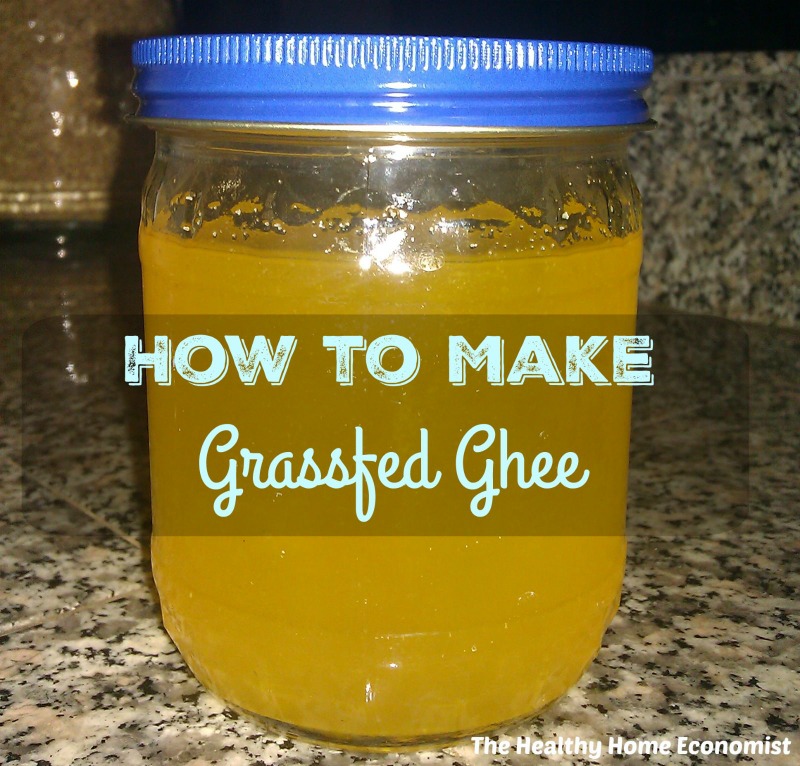
Knowing how to make ghee is simply a must for any Traditional Cook. Clarified butter as it is also known, has been used for thousands of years by Indian cultures. In fact, traces of ghee have been found on fragments of Indian pottery dating as far back as 6500 BC!
When in a liquid state and made from unheated butter, ghee is called butter oil. Dr. Weston A. Price discovered that butter oil and cod liver oil work synergistically to supercharge absorption of Vitamins A, D, and K2 known as the X-factor.
Dr. Price always carried flasks of cod liver oil and butter oil to the bedside of very ill patients. More often than not, he was able to revive them with a few drops of each under the tongue. Using cod liver oil or butter oil separately did not have the same deathbed reviving effects.
Benefits of Ghee over Other Cooking Fats
It is best to know how to make clarified butter oil or ghee yourself rather than buying from the store. Notice the picture above of a jar that I made myself with pastured butter from a local farm. It is so yellow!
Commercial ghee from the store is a pale yellow, indicating lower nutritional value from cows eating grain mix instead of fresh green grass.
Ghee from the store is also ridiculously expensive, so learning to make it yourself is not only a more nutritious way to go, it is very cost-effective.
I make clarified butter oil for about half the cost of what it would be to buy it at the health food store.
Unlike butter, ghee does not need refrigeration and keeps well on the counter or pantry for many months. Keeping a jar in the pantry for a quick veggie saute is very convenient!
Another benefit of ghee is that it is easier to digest as all the milk solids (proteins) have been removed from the butter. Very frequently, even those with a true dairy allergy find that ghee presents no trouble for them.
Another advantage to using clarified butter instead of plain grass-fed butter is that the grassy taste and sometimes cheesy smell of the butter is eliminated.
Therefore, by learning to make clarified butter oil from grass-fed butter, you will find that you now have a healthy fat for cooking that does not displease your family with a cheesy odor. This can sometimes happen with grass-fed butter alone.
Homemade Grass-Fed Ghee
The recipe and video lesson below covers how to make this healthy and indispensable fat for use in your own kitchen.
I also cover how to make clarified butter capsules. This is a convenient way to take butter oil with your daily dose of cod liver oil.
If you are spending money on high vitamin cod liver oil (this is the brand I’ve used since 2015) it is a must to be taking it with clarified butter oil. This supercharges the beneficial effects!
Note that it is not advisable to make ghee from homemade raw butter. The heating process causes a loss of the enzyme and probiotics in this special food.
Prefer to Buy?
If after reviewing the recipe and video demo below you decide to buy instead, I would recommend this vetted source as a premier retailer of quality grass-fed ghee. Plain, cultured, and herb-flavored varieties are all available including a coconut oil/ghee blend.
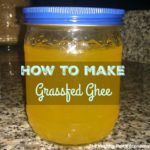
How to Make Ghee
This simple recipe for making ghee can be accomplished on the stovetop in just a few minutes.
Ingredients
- 1 lb butter preferably grassfed and organic
- 1 wide mouthed mason jar quart size
- 1 cheesecloth fine mesh
- 1 funnel
Instructions
-
Place pound of butter in a medium sized pot or stove safe glass bowl. Turn heat on low and allow the butter to gently liquefy.
-
Turn heat to medium-low and gently remove foam that comes to the top of the melted butter with a slotted spoon.
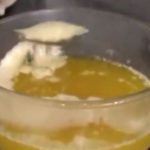
-
After removing the foam, allow the melted butter to simmer on medium-low heat for 5-10 minutes longer to allow all the milk solids to settle out on the bottom of the bowl. You will know when the separation process is complete as the solids will be slightly brown on the bottom and the clarified butter will be completely clear and transparent.
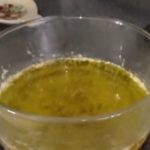
-
Line a funnel placed into the open end of a wide mouthed mason jar with a fine mesh cheesecloth.
-
Pour the clarified butter into the funnel so that it is strained through the cheesecloth as it enters the mason jar.
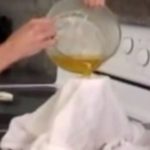
-
Allow the finished ghee to cool in the mason jar. When room temperature, fasten the lid on tightly and store in the pantry as a convenient and incredibly healthy cooking oil for all your kitchen needs.








Speaking of butter oil…my whole family takes FCLO and HVBO except the baby who just takes FCLO. What age should I introduce HBVO to her? She is 9 months old.
Thank you for such an informative blog. I will have to try making ghee.
Hi Sarah, she should be taking it now. Butter oil is included in the homemade baby formula video for newborns through age one, so your daughter can start taking it right away.
Hi Sarah,
Thank you so much for this instructive and money saving video! I always wondered why my grassfed butter from the farmer had such a smell! I am so glad you mentioned this as I thought it was just me or just my farmer. I guess “cheesy” is a good way to describe it – or just foul… I never made ghee from it, as I thought the ghee would smell just as bad. I may try to make the ghee from grassfed butter again. Thanks!
Sarah,
I have a jar of ghee from Ancient Traditions and a jar of coconut ghee from Green Pastures in my fridge. Can I put them in the pantry. They are awful hard to scrape out of the jar cold! How long at room temp will these last?
Mikki
Hi Mikki, I have Green Pastures coconut ghee in my pantry as well. That and your store bought ghee should last a minimum of 3-4 months if not up to a year in the pantry.
Thanks! I’m taking them out!
Being a little knew to the idea of cooking with butter, I have a question: I had recently heard that using butter in high-heat situations like frying was not a good idea in that the high heat actually damaged the oil and made the oil carcinogenic. I would really like some feedback on this. I have no problem whatsoever in using butter after cooking, as much as everyone wants and we LOVE the taste of butter!
Hi Merry Lynn, butter burns when you cook it too high, but ghee has all the milk solids which burn removed, so it has a very high smoke point. This is not to say that you can’t heat it to a high enough temperature to damage it, which of course you can. But, for the majority of cooking situations – even frying – ghee is a wonderful choice. Butter could never be used for frying, however.
We have just recently reintroduced butter into our household so I am really excited to try this!
One of my sons has a life-threatening allergy to dairy, but has been able to seemingly tolerate more exposure recently so I am also going to check w/ his allergist about doing a small food challenge with ghee – since you reminded me that all of the proteins are removed and that is the part that causes the allergic reaction.
I have a few questions, however –
1. how much protein is there actually in butter as it is all fat and the nutritional labels for butter show it as having no protein?
2. How much ghee do you end up getting from about a pound of butter
3. Would the quality of ghee made from grass fed beef be equivalent to that of Green Pasture’s butter oil? This sure would be a lot cheaper!
Thanks for the informative post!
Hi Adrienne, there really isn’t much in the way of milk solids in the butter. Check out the video and you will see at the end the milk solids at the bottom of the baking dish. You really don’t discard much at all when making ghee. The Green Pasture’s butter oil is centrifuged and is raw so would be better than homemade from that standpoint. The soil where Dave’s farm is is so rich that it is a good idea to be getting some of that as well. We just use so much butter oil in our home – particularly for cooking – that we simply must make it.
It also concerns me that so many folks do not take butter oil with their fermented cod liver oil. It is a shame as the two together work so much better. The butter oil from Green Pastures is pricey which is why I think folks in this economy buy the fermented cod liver oil first – which is the correct choice. BUT, there is a way to take the butter oil anyway by making it yourself if price is an issue which is why I was motivated to make this video.
Hi Allison, the Green Pastures butter oil is raw, so would be better from that standpoint than homemade, but money-wise making it at home is a very very good option for those who would not buy it otherwise due to the price. 1/2 tsp a day is a wonderful dose with your fermented cod liver oil.
We use ghee in daily basis in my recipes and on our rotis(bread).My question is do we need to take it still with code liver oil in mornings or only code liver oil will be fine.
How many butter oil capsules (size?) do we take with our Green Pastures FCLO?
1/2 tsp of butter oil per day is great, so that would be about 2 of the jumbo capsules that you buy empty at the healthfood store.
Thanks for the great video, Sarah! I’m going to get some of my new-spring-grass-butter into ghee as soon as possible! A quick question: what is the benefit of taking the butter oil in a capsule as opposed to on a spoon like you would with cod liver oil? Also, is there anything in the makeup of an empty capsule that could be harmful if taken regularly? If you are not taking cod liver oil (working on the budget still!), is there any benefit to taking butter oil alone?
Hi Diana, butter oil off the spoon is fine .. but it is sometimes easier to pop a few capsules. especially with kids who don’t like stuff off the spoon. Also, the capsules are great for traveling. Butter oil is wonderful alone .. it just is supercharged in effectiveness with the fermented cod liver oil.
Hi Sarah,
I appreciate your posts so much. I have an almost two year old that has some early signs of tooth decay that I am wanting to reverse. We follow a very traditional diet but I have not been consistent with FCLO or butter oil. Will he get the same benefits if I mix the oils in something like apple sauce or oat meal, as opposed to straight off the spoon?
Thanks so much.
I’ve never been successful making ghee, so maybe I’ll try it again after viewing your video. I like the idea that it doesn’t need refrigeration. My fridge is always loaded to the gills with other homemade dairy goodies! Whey, cream cheese, sour cream, buttermilk, kefir, yogurt, greek yogurt, creme fraiche . . . the list goes on. ;->)
Just want to thank you for all your wonderful videos-you have opened my eyes to a lot and encouraged me to try many things I may not have had the courage (or incentive) to!!
You’re welcome, Arlene! I am glad that the videos are encouraging you to try some new things in your kitchen! 🙂